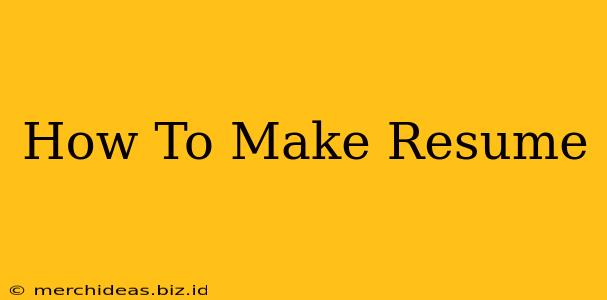Landing your dream job starts with a killer resume. This comprehensive guide will walk you through creating a resume that not only gets noticed but also secures you interviews. We'll cover everything from choosing the right format to highlighting your accomplishments, ensuring your resume is optimized for Applicant Tracking Systems (ATS) and recruiters alike.
Choosing the Right Resume Format
The first step in creating a powerful resume is selecting the appropriate format. There are three main types:
-
Chronological Resume: This classic format lists your work experience in reverse chronological order, starting with your most recent role. It's best for candidates with a consistent work history and career progression.
-
Functional Resume: This format emphasizes your skills and accomplishments over your work history. It's ideal for career changers, individuals with gaps in their employment history, or those with limited work experience.
-
Combination Resume: This format blends elements of both chronological and functional resumes, highlighting both your skills and work experience. It's a versatile option suitable for many situations.
Which format should you choose? Consider your experience level and career goals. If you have a strong, consistent work history, a chronological resume is often the best choice. If you're changing careers or have gaps in your employment, a functional or combination resume might be more effective.
Crafting Compelling Content: Keywords and Skills
Your resume needs to speak to both humans (recruiters) and machines (Applicant Tracking Systems). This means incorporating relevant keywords and showcasing your skills effectively.
Identifying Keywords:
-
Job Description Analysis: Carefully review the job descriptions you're applying for. Identify keywords and phrases used to describe the required skills and experience. Incorporate these keywords naturally throughout your resume.
-
Industry Research: Research common keywords used within your industry. Use online job boards and industry publications to identify relevant terms.
Highlighting Your Skills:
-
Quantifiable Achievements: Don't just list your responsibilities; quantify your accomplishments. Use numbers and data to demonstrate your impact. For example, instead of saying "Managed social media accounts," say "Increased social media engagement by 25% in six months."
-
Action Verbs: Start your bullet points with strong action verbs that showcase your accomplishments (e.g., managed, developed, implemented, achieved, increased, reduced).
-
Skills Section: Include a dedicated skills section listing both hard skills (technical skills) and soft skills (interpersonal skills). Tailor this section to the specific requirements of each job application.
Designing a Visually Appealing Resume
While content is king, presentation matters. A visually appealing resume makes a positive first impression.
-
Clean and Concise: Keep your resume concise and easy to read. Use clear headings, bullet points, and white space to improve readability.
-
Professional Font: Choose a professional and easy-to-read font such as Times New Roman, Arial, or Calibri.
-
Consistent Formatting: Maintain consistent formatting throughout your resume, including font size, spacing, and bullet points.
-
Contact Information: Clearly display your name, phone number, email address, and LinkedIn profile URL (optional).
Optimizing Your Resume for ATS
Many companies use Applicant Tracking Systems (ATS) to screen resumes. To ensure your resume gets past the ATS, follow these tips:
-
Use Plain Text: Avoid using fancy formatting or graphics that may not be compatible with ATS.
-
Save as PDF: Save your resume as a PDF to preserve formatting and ensure consistent rendering across different devices.
-
Keyword Optimization: As mentioned earlier, incorporating relevant keywords is crucial for ATS compatibility.
Proofreading and Refinement
Before submitting your resume, meticulously proofread it for any errors in grammar, spelling, or punctuation. Have a friend or family member review it for a fresh perspective.
Conclusion
Creating a high-impact resume is an investment in your career. By following these steps and tailoring your resume to each job application, you'll significantly increase your chances of landing interviews and achieving your career goals. Remember to constantly update your resume to reflect your latest achievements and skills. Good luck!
